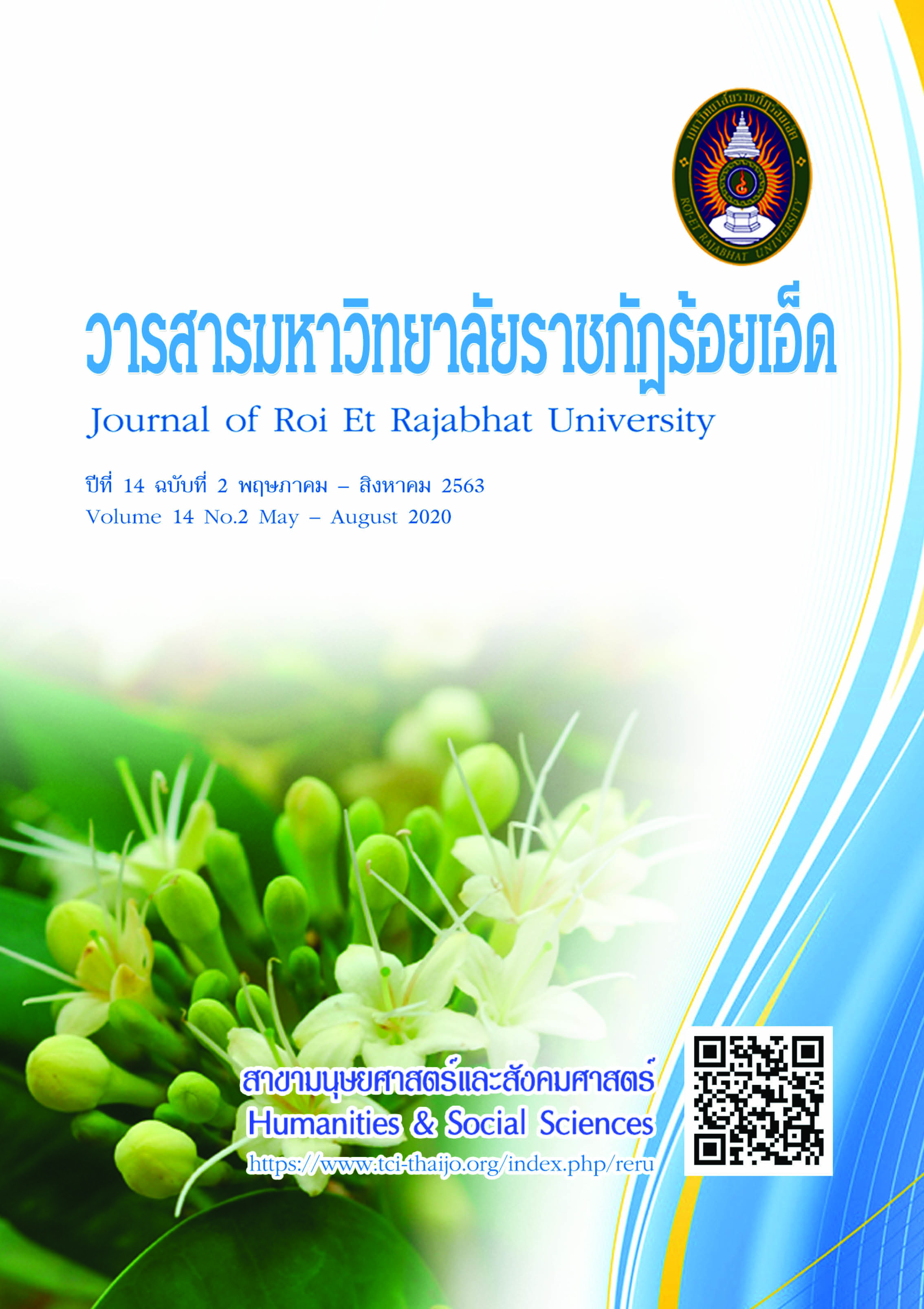The Study of Tourists’ Motivation towards Restaurant Service: A Case Study of Restaurant Service in Mahasarakham Province
Keywords:
Pull factors, Gastronomy Tourist, RestaurantAbstract
The purpose of this research was to study the tourists’ motivation toward restaurant services: a case study of restaurant service in Mahasarakham province. The sample group of the study included 400 Thai tourists who used the service in local restaurants in 4 districts of Mahasarakham Province; Mueang Mahasarakham, Kantharawichai , Wapi Pathum and Kae Dam. This research is a quantitative research and the data were collected by using questionnaires. Quota sampling method was used in this study. The researcher collected the data from Thai tourists In 4 areas as mentioned, 100 tourists in each area. Statistics used for data analysis are descriptive statistics, mean, and standard deviation. The motivation that affects the use of restaurants in Mahasarakham province is at moderate level in overall. The motivation of demand for having food with friends, relatives or family (Social) is at the highest level, following with the demand for cheap or budget food (Budget), the demand for food that has the combination between ingredients and style (Eclectic). The Motivation that affects the use of restaurant service in Mahasarakham Province is at a high level in overall. The highest mean of the motivation of using service in restaurants based on the quality of food is the taste, based on the environment is the service and the tourists’ motivation of choosing the restaurant based on food are appearance and food decoration.
References
กระทรวงการท่องเที่ยวและกีฬา. (2560). สถิตินักท่องเที่ยวภายในประเทศ ปี 2559 (จำแนกตามภูมิภาคและจังหวัด). สืบค้นเมื่อ 15 พฤษภาคม 2560, จาก https://www.mots.go.th/more_news.php?cid=438&filename=index
กรุงเทพธุรกิจ. (2560). ครม.ไฟเขียวโครงการ มิชลิน ไกด์ ไทยแลนด์. สืบค้นเมื่อ 14 กุมภาพันธ์ 2560, จาก http://www.bangkokbiznews.com/news/detail/740480
ชญานิน วังซ้าย. (2560). Food will keep us alive. จุลสารวิชาการการท่องเที่ยว, 3(1), 61-66.
เบญจมาภรณ์ ชำนาญฉา. (2561). การท่องเที่ยวเชิงอาหาร: ศักยภาพและความได้เปรียบของประเทศไทย. วารสารวิชาการ สมาคมสถาบันอุดมศึกษาเอกชนแห่งประเทศไทย ในพระราชูปถัมภ์ สมเด็จพระเทพรัตนราชสุดาฯ สยามบรมราชกุมารี, 24(1), 103-116.
บัณฑิต อเนกพูนสุข. (2560). Food on the move. จุลสารวิชาการการท่องเที่ยว, 3(1), 8-19.
โตมร ศุขปรีชา. (2560). Food tourism 2.0. จุลสารวิชาการการท่องเที่ยว, 3(1), 43-51.
ธีรภัทร ตียาสุนทรานนท์ และศิริพงศ์ รักใหม่. (2562). พฤติกรรมและปัจจัยส่วนประสมทางการตลาด ที่มีผลต่อความพึงพอใจของผู้ใช้บริการร้านอาหารพื้นเมืองในจังหวัดเชียงใหม่. วารสารวิทยาลัยดุสิตธานี, 13(1), 302-314.
ผู้จัดการออนไลน์. (2560). อาหารไทยเพื่อการท่องเที่ยว ตลาดโตต่อเนื่องทะลุ 4.5 แสนล้าน. สืบค้นเมื่อ 11 พฤษภาคม 2560,
จาก https://mgronline.com/business/detail/9600000047488
สริตา พันธ์เทียน, ทรงคุณ จันทรจร, และมาริสา โกเศยะโยธิน. (2560). รูปแบบการจัดการท่องเที่ยวเชิงอาหารไทย โดยใช้แนวคิดเศรษฐกิจสร้างสรรค์ในเขตลุ่มแม่น้ำภาคกลาง. วารสารวิจัยและพัฒนา มหาวิทยาลัยราชภัฎสวนสุนันทา, 9(3 ฉบับพิเศษ), 190-198.
สำนักงานจังหวัดมหาสารคาม. (ม.ป.ป). สถานที่ท่องเที่ยว. สืบค้นเมื่อ 11 พฤษภาคม 2560, จาก http://www.mahasarakham.go.th
อัศวิน แสงพิกุล. (2556) ระเบียบวิธีวิจัยด้านการท่องเที่ยวและการโรงแรม. กรุงเทพฯ: มหาวิทยาลัยธุรกิจบัณฑิตย์.
Cohen, E., and Avieli, N. (2004). Food in Tourism: Attraction and Impediment. Annals of Tourism Research, 31(4), 755-778.
Hall, C. M., Sharples, L., Mitchell, R., Macionis, N., and Cambourne, B. (2003). Food Tourism around the world: Development, management and markets. New York: Butterworth-Heinemann.
Krejcie, R. V., and Morgan, D. W. (1970). Determining Sample Size for Research Activities. Educational and Psychological Measurement, 30(2), 607-610.
Kururatchaikul, P. (2014). Food tourism in Thailand: Consumer behaviors of foreign tourists in Thailand. Japan: Waseda University.
Quan, S., and Wang, N. (2004). Toward a structural model of the tourist experience: an illustration from food
experiences in tourism. Tourism management, 3(25), 297-305.
Scarpato, R. (2003). Gastronomy as a tourist product: the Perspective of Gastronomy Studies. London: Routledge.
World Food Travel Association. (2018). What Is Food Tourism?. Retrieved May 14, 2018, from https://www.worldfoodtravel.org/cpages/what-is-food-tourism
United Nations World Tourism World Tourism Organization : UNWTO. (2012). Global report on Food Tourism.
Madrid: UNWTO.
Downloads
Published
How to Cite
Issue
Section
License
บทความที่ได้รับการตีพิมพ์เป็นลิขสิทธิ์ของวารสารมหาวิทยาลัยราชภัฎร้อยเอ็ด
ข้อความที่ปรากฏในบทความแต่ละเรื่องในวารสารวิชาการเล่มนี้เป็นความคิดเห็นส่วนตัวของผู้เขียนแต่ละท่านไม่เกี่ยวข้องกับมหาวิทยาลัยราชภัฎร้อยเอ็ด และคณาจารย์ท่านอื่นๆในมหาวิทยาลัยฯ แต่อย่างใด ความรับผิดชอบองค์ประกอบทั้งหมดของบทความแต่ละเรื่องเป็นของผู้เขียนแต่ละท่าน หากมีความผิดพลาดใดๆ ผู้เขียนแต่ละท่านจะรับผิดชอบบทความของตนเองแต่ผู้เดียว





